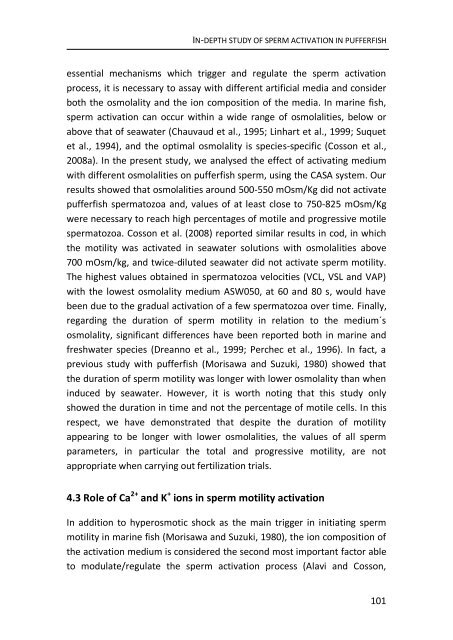chapter 3 - RiuNet
chapter 3 - RiuNet
chapter 3 - RiuNet
Create successful ePaper yourself
Turn your PDF publications into a flip-book with our unique Google optimized e-Paper software.
IN-DEPTH STUDY OF SPERM ACTIVATION IN PUFFERFISH<br />
essential mechanisms which trigger and regulate the sperm activation<br />
process, it is necessary to assay with different artificial media and consider<br />
both the osmolality and the ion composition of the media. In marine fish,<br />
sperm activation can occur within a wide range of osmolalities, below or<br />
above that of seawater (Chauvaud et al., 1995; Linhart et al., 1999; Suquet<br />
et al., 1994), and the optimal osmolality is species-specific (Cosson et al.,<br />
2008a). In the present study, we analysed the effect of activating medium<br />
with different osmolalities on pufferfish sperm, using the CASA system. Our<br />
results showed that osmolalities around 500-550 mOsm/Kg did not activate<br />
pufferfish spermatozoa and, values of at least close to 750-825 mOsm/Kg<br />
were necessary to reach high percentages of motile and progressive motile<br />
spermatozoa. Cosson et al. (2008) reported similar results in cod, in which<br />
the motility was activated in seawater solutions with osmolalities above<br />
700 mOsm/kg, and twice-diluted seawater did not activate sperm motility.<br />
The highest values obtained in spermatozoa velocities (VCL, VSL and VAP)<br />
with the lowest osmolality medium ASW050, at 60 and 80 s, would have<br />
been due to the gradual activation of a few spermatozoa over time. Finally,<br />
regarding the duration of sperm motility in relation to the medium´s<br />
osmolality, significant differences have been reported both in marine and<br />
freshwater species (Dreanno et al., 1999; Perchec et al., 1996). In fact, a<br />
previous study with pufferfish (Morisawa and Suzuki, 1980) showed that<br />
the duration of sperm motility was longer with lower osmolality than when<br />
induced by seawater. However, it is worth noting that this study only<br />
showed the duration in time and not the percentage of motile cells. In this<br />
respect, we have demonstrated that despite the duration of motility<br />
appearing to be longer with lower osmolalities, the values of all sperm<br />
parameters, in particular the total and progressive motility, are not<br />
appropriate when carrying out fertilization trials.<br />
4.3 Role of Ca 2+ and K + ions in sperm motility activation<br />
In addition to hyperosmotic shock as the main trigger in initiating sperm<br />
motility in marine fish (Morisawa and Suzuki, 1980), the ion composition of<br />
the activation medium is considered the second most important factor able<br />
to modulate/regulate the sperm activation process (Alavi and Cosson,<br />
101
















